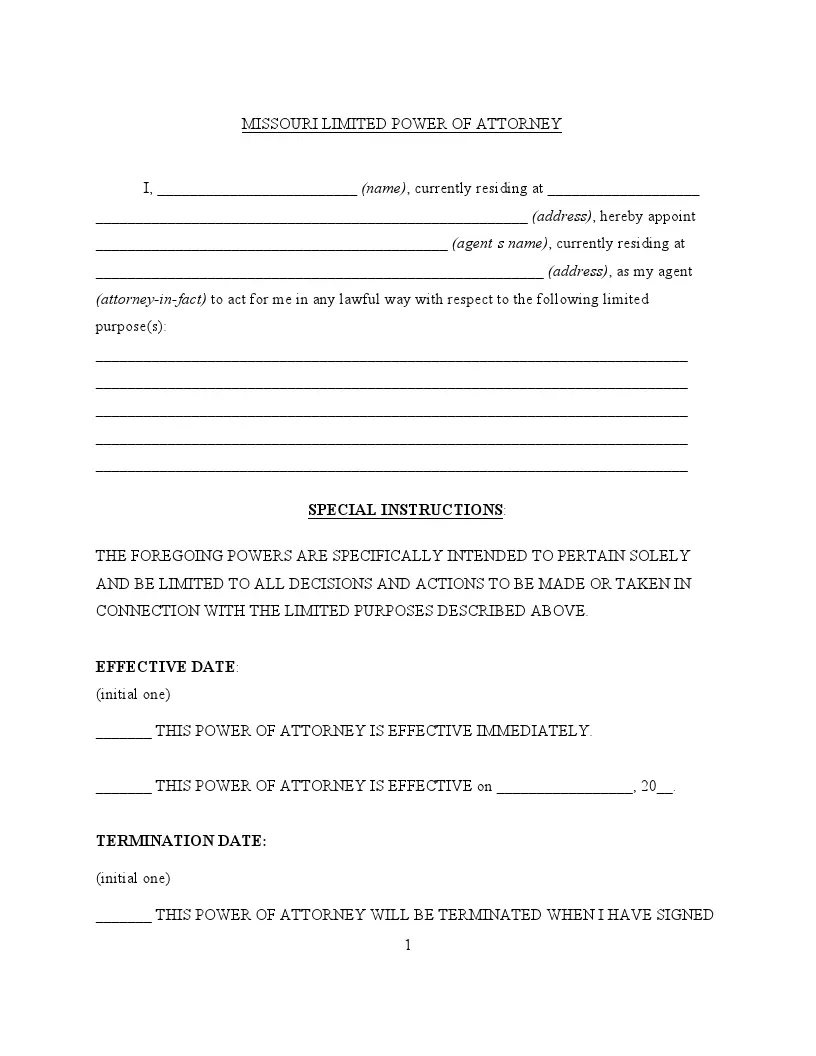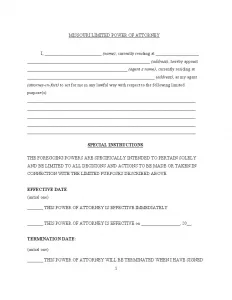Missouri Limited Power of Attorney Form
A Missouri limited power of attorney is a legal form that authorizes a designated individual (agent) to represent another person (principal) exclusively under certain conditions or for specific duties. This type of power of attorney is more restrictive than its general counterpart, focusing the agent’s authority on specified tasks like property sales, financial management, or business operations.
This document proves especially beneficial when the principal cannot personally fulfill these responsibilities due to travel, illness, or limited time availability. The powers conferred through this document can be customized to meet exact requirements. For example, it might be set to last just for a single day or throughout the completion of a particular transaction.
In Missouri, as in other states, this document must clearly define the scope of the authority granted to the agent. You can find all Missouri power of attorney forms online to establish legal permissions in specific circumstances.

Build Your Document
Answer a few simple questions to make your document in minutes
Save and Print
Save progress and finish on any device, download and print anytime
Sign and Use
Your valid, lawyer-approved document is ready
Under the Missouri Revised Statutes — Durable Power of Attorney (§ 404.700 – § 404.737), the document grants an attorney-in-fact the ability to perform actions explicitly outlined within the agreement. These actions are limited to the scope defined by the principal, preventing any extension beyond agreed-upon terms. Important things to keep in mind are:
- Authority is granted for specified tasks only, as detailed in the power of attorney.
- The attorney-in-fact must act within the strict boundaries of the power granted.
- Actions beyond the specified authority are not permitted.
Missouri law strongly recommends notarization when signing a limited power of attorney, especially if the power of attorney is durable and involves the transfer of real property. The document must be acknowledged according to state regulations and recorded to ensure it is legally binding.
Missouri Limited Power of Attorney Form Details
| Document Name | Missouri Limited Power of Attorney Form |
| Other Name | Missouri Special Power of Attorney |
| Relevant Laws | Missouri Revised Statutes, § 404.710 |
| Avg. Time to Fill Out | 8 minutes |
| # of Fillable Fields | 32 |
| Available Formats | Adobe PDF |
Filling Out Missouri Limited POA
Completing a limited power of attorney in Missouri allows you to appoint someone to act on your behalf in specific legal or financial matters. Below is a step-by-step guide to help you fill out this form correctly to ensure your needs are met and the document complies with Missouri law.
1. Enter the Principal’s Information
Start by writing your full name and address in the designated areas at the beginning of the form. This field identifies you as the principal, the person granting the power of attorney.
2. Appoint Your Agent
Designate your chosen agent by entering their full name and address. This is the individual you are authorizing to act on your behalf. Ensure this person is someone you trust completely, as they will have significant legal authority in the specified matters.
3. Define the Powers Granted
Specify the exact powers you are granting to your agent. This section should clearly outline the limitations and specific tasks your agent can perform. Be as detailed as possible to avoid any ambiguity.
4. Set the Effective Date
Choose when the powers will come into effect. You can opt for the power of attorney to be effective immediately or specify a future start date. Initial the choice that applies.
5. Determine the Termination Date
Decide when the power of attorney will expire. It can be a specific date, upon a signed written revocation, or when you are determined to be incapacitated. Initial next to the selected option to validate it.
6. Appoint a Successor Agent (Optional)
If you wish, appoint a successor agent who will take over if your first agent cannot serve. Provide the name and address of the successor, ensuring they are also a reliable and trustworthy person.
7. Sign and Date the Form
Once all sections are completed, sign and date the form in the presence of a notary. This step legally enforces the document.
8. Notarization
Have a notary public verify your identity and witness your signature. The notary will fill out the acknowledgment section, confirming that you are signing the document and doing this willingly and under no duress.
9. Distribute Copies
After notarization, distribute copies of the completed document to your agent, successor agent (if applicable), and any institutions or individuals interacting with the agent under this power.
